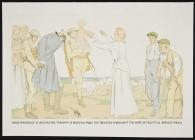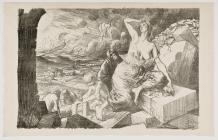Ideals
“To lose sight of Britain's ultimate ideals of freedom and democratic justice is to reduce the present war to nothing less than a carnival of carnage” (Burton Daily Mail, Feb 15, 1918)”
Twelve artists each contributed a large colour lithograph to this section. Some of the artists, including Brangwyn and F. Ernest Jackson were accomplished lithographers, whilst for others, such as Clausen and Grieffenhagen, it was the first time that they had used the technique.
The Ideals express the aims and ambitions of the war through use of allegory and symbolism. Allegory is a traditional form of representation in art in which historical or mythological figures are used to communicate broader ideas and concepts. In Ideals, the message and meaning of the composition is referenced by the title of each work. Countries and concepts are represented as figures and forms. Although allegorical representation had been out of artistic fashion for some time when these prints were made, it was used here as a propaganda tool to emphasise the importance of the objectives. Through grandiose associations, the prints aimed to justify the means and realities of the war for ordinary people.
Although many people praised the project, The Ideals received some criticism for their idealistic portrayal of war.









